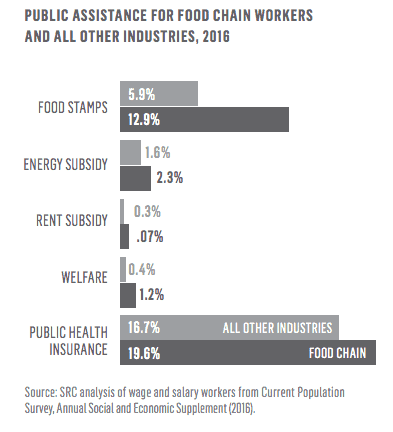The food industry is one of the most profitable sectors in the US and the largest private employer in the country. Yet, 80% of industry workers earn poverty level wages.
The median wages for frontline workers in the industry is just $10 an hour, as opposed to the $17.53 in all other industries. In addition to that race, ethnicity and gender play a vital role in determining how much money you make as a food worker.
-
- In many states, restaurant workers receive a tipped minimum wage – frozen at $2.13 in 16 states.
- 30% of all farmworkers had total family incomes below the poverty line. Farmworkers also often get paid a ‘piece-rate’, which incentivizes them to skip shade and water breaks in order to make enough wages to get by. The median income for farm workers today is $10.66 an hour, and many are price-gouged on housing costs and more.
- Tipped workers are also more susceptible to wage theft and sexual abuse in the work place.

What’s keeping wages down?
The more appropriate question would be ‘Who’? As an article in The Guardian puts it, “over decades, employers have built and maintained a massive collective political apparatus to hold down wages.”
The National Restaurant Association, which represents the $600 billion restaurant industry and has an annual budget of over $50 million has successfully lobbied against increasing minimum wage for the last few decades. The food industry in particular has some of the largest, most economically and politically powerful corporations in the country and their business models hinge on keeping wages down. Many of these companies have regional or national control over workers wages. For instance, poultry giant Tyson is one of the largest employers Arkansas and they have been found guilty of illegal coordination over worker pay, while retail giant Amazon who employs almost 1 million people in the U.S. — that’s 1 in every 169 workers — successfully crushed workers’ efforts to unionize in early 2021. According to a recent report by the Union of Concerned Scientists, “when few companies operate per county, they can more easily illegally coordinate with each other over the terms of employment for their workers.”
Interested in exploring this further? Check out this table showing minimum wages for tipped employees by state and head to the websites of Food Chain Workers Alliance, Restaurant Opportunities Center(ROC) and One Fair Wage to learn more about why workers deserve a better pay, and how they are fighting to make that happen.